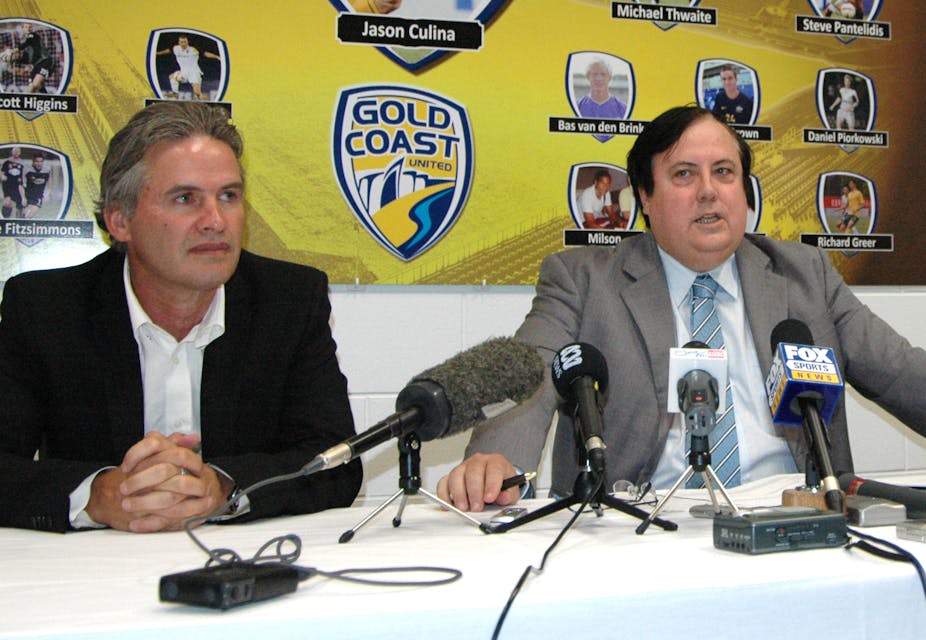The public slanging match between two heavy-hitters of Australian business, Clive Palmer and Frank Lowy, has highlighted football’s reliance on private ownership.
Private ownership is a logical model for a start-up competition such as the A-League to adopt because it gives the game the injection of capital it needs to get up and running.
Keeping football afloat
Funding football like this is a bit like the toll road a government can’t afford to build on its own. It needs the road now so it goes into partnership with the private sector. But like many infrastructure projects, the public/private funding model of football has led to acrimony between some club owners and the not-for-profit governing body.
Club owners tip in huge amounts of their own cash to keep clubs afloat, and therefore keep the league running. This was crucial while the A-League established credibility and a fan base. The next step was to continue to increase the standard and popularity of the competition. The pay-off for that should come soon with increased media rights revenue that will take the pressure off the capital investment by private owners.
But although he clearly could afford to wait, it seems Clive Palmer has become impatient with how quickly the Football Federation of Australia (FFA) is moving away from the model that relies on private ownership to underpin the league.
Bringing down the A-League
In recent weeks, the billionaire mining magnate has been vitriolic in his criticism of the A-League competition, labelling it “a joke” and calling football a “hopeless game”.
The FFA desperately needs wealthy private owners to bank roll the A-League, but it also decided it couldn’t afford Palmer’s price tag of what he called “freedom of speech”.
That is why the FFA severed ties with Palmer so swiftly. He wasn’t just a disgruntled private owner who wanted a better deal for his club, he was publicly questioning the market value of the A-League.
Rights and responsibilities
It wasn’t so long ago there were mutterings among the football community that Fox Sports had picked up the rights to the A-League for a song, such was the popularity of the competition.
The seven-year contract might have been two years too long when it was signed in 2006, but its estimated value of A$120m saved the national competition.
The next contract is supposed to be the game’s pay day. A chance to increase the salary cap, attract better players and in turn develop a stronger and more attractive league.
The current dispute with Palmer probably doesn’t alter the equation for prospective rights bidders but it does raise the question of whether in the long run, football needs private ownership to survive.
It is unlikely rival broadcasters will try to outbid Fox Sports for the media rights but despite that, and the recent turmoil, the FFA is likely to be able to negotiate a television deal that will move private owners closer to a model where their clubs are self-funded.
For love or money
Professional clubs are one of two things – they are either win maximisers or profit maximisers. Several AFL clubs spend more than they earn chasing their holy grail, the Premiership Cup. Winning is everything and they spend everything and more, chasing victory. The AFL has the money to prop them up and does so because that relentless pursuit for the premiership is at the core of the code’s success in maximising rights revenue.
In the United Kingdom, the top premier league clubs chase silverware at almost any cost. The global popularity of the English Premier League, is due in part to the single-mindedness of private owners to invest or borrow to buy the best players in the world in order to win. In turn, the standard of play goes up and television viewership increases.
But many private owners in the NFL in the United States opt for a profit-maximiser model. They want to win but not at all costs. If this means a decade or more finishing mid-table with no prospect of a place in the Super Bowl, then so be it.
The last thing the local competition needs is for owners to rack up huge debts chasing silverware.
The introduction of a salary cap was a sensible and necessary measure, but the dilemma for the FFA is simple. How quickly can it move to a model where the A-League isn’t predominantly funded by private owners and their occasional, idiosyncratic whims?

